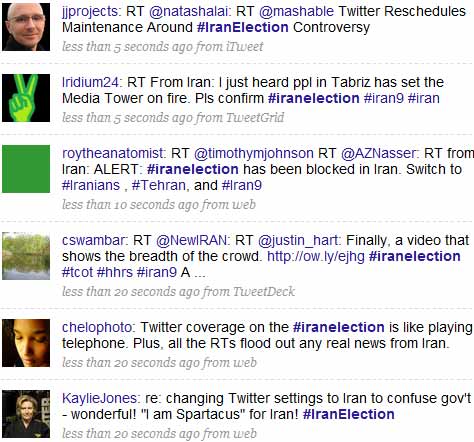With two-thirds of the votes counted, the Islamic Republic News Agency, Iran's official news agency, announced that incumbent Mahmoud Ahmadinejad had won the election with 66% of the votes cast, and that Mir-Hossein Mousavi had received 33% of the votes cast. The European Union and several western countries expressed concern over alleged irregularities during the vote, and some analysts and journalists from United States and United Kingdom based media voiced doubts about the authenticity of the results.
Mousavi issued a statement saying, "I'm warning that I won't surrender to this charade," and he urged his backers to fight the decision as well as to avoid committing acts of violence. Protests, in favour of Mousavi and against the alleged fraud, broke out in Tehran. Supreme Leader Ayatollah Ali Khamenei urged the nation to unite behind Ahmadinejad, labeling his victory as a "divine assessment". Mousavi lodged an official appeal against the result to the Guardian Council on 14 June. On 15 June, Khamenei announced there would be an investigation into vote-rigging claims, which would take seven to ten days.
Some of the reasons for questioning the veracity of the election results were, victory was declared very quickly making people wonder how the paper ballots could have been counted so rapidly. Polls prior to the election had shown the race as close, yet the 'results' indicated a landside. Mousavi's own home town even reported an overwhelmingly victory for Ahmadinejad. Clearly there was distrust amongst many of the Iranian people of the government as massive protests erupted and continue even now.
So what does Twitter have to do with this? Once protests started the Iranian government shut down public communications leaving citizens little means to communicate. Twitter, obviously not under the control of the Iranian government, is one of the few remaining tools for communication amongst the citizens of Iran. And it isn't just that Twitter is helping citizens communicate, it is a major player in getting the word out about what it is actually happening in Iran.
Network and cable news dropped the ball in their coverage of the elections, and over the weekend one of the hottest topics on Twitter was #cnnfail. However, the hottest topic was #IranElections. The Twitter feed was the first source for much of the news coming out of Iran. Here are examples of recent #IranElection tweets...

The images being posted via Twitter have been remarkable, and the Flicker account of mousavi1388 is definitely worth looking at.
A "mousavi1388" image of the protests via Twitter.

This has taken on a life of its own on Twitter. Users have set up proxy servers for Iranians to use as the government shut down internet access within the country. People are turning their Twitter avatars green in a show of support. Twitter itself has rescheduled maintenance downtime at the urging of users so that it will be available to Iranians during their peak hours. People are also changing their time and location settings on their accounts to Tehran time and locale in order to confuse Iranian officials who are trying to find out who is tweeting inside Iran. Even at this moment the hashtag (or keywords) #IranElection is being changed as it appears the Iranian government may be blocking it in Iran.
The Iranian government post election has done everything possible to show itself as a totalitarian regime by cutting off communication and violently suppressing protests. They are taking actions that those in the U.S. whether conservative or liberal can clearly see as wrong. It makes this a fascinating moment in history where technology and communications may actually be aiding freedom and democracy, while providing a first person account of events that the media has yet to fully come up to speed on.
Following Iran Elections on Twitter A Lesson on Freedom and Technology
No comments:
Post a Comment